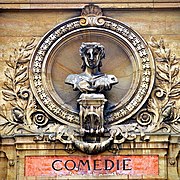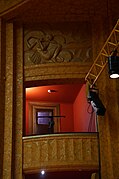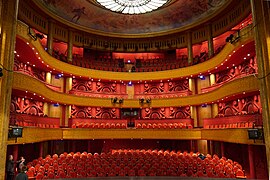Draft:Reims Opera House
The content of this article is translated from the existing French Wikipedia article at fr:Opéra de Reims; see its history for attribution.
| Opéra de Reims | |
|---|---|
 | |
 | |
| General information | |
| Coordinates | 49°15′15″N 4°01′51″E / 49.254031°N 4.030863°E |
| Design and construction | |
| Architect(s) | Alphonse Gosset François Maille & Louis Sollier |
The Opera of Reims is a building located in Reims, France. It was designed by Reims architect Alphonse Gosset, with the collaboration of Narcisse Brunette and Ernest Leclère, and inaugurated in 1873[1].
Originally an Italian-style theater with 1200 seats, it was expanded by 100 seats during its restoration in 1931. The theater features a brightly lit ceiling and a circular frieze themed around the arts of theater. Although the building's architecture is neoclassical, all the interior decorations are in Art Deco style (bas-reliefs, ironwork, chandeliers, paintings, etc.).
Location
[edit]It is located in the heart of the city, at 13 rue Chanzy, between the courthouse and the Museum of Fine Arts. At the intersection of Rue de Vesle and rue Chanzy, it is served by the tramway lines A and B, as well as bus lines 1, 2, 3, 4, 5, 6, 8, 9, 16, 30, 40, City bus, and TAD violet of the Citura network at the "Opéra" and "Carnot" stations.
History
[edit]In the early eighteenth century, Reims did not have a proper theater. At that time, the taste for theatrical performances became a passion for Parisians and quickly spread from the capital to the provinces. The oldest theater was located on rue Buirette (then rue Large), at the corner of rue Caqué, built in 1755 by Regnault, in the premises of the Jeu de Paume. In 1790, Draveny, the owner of a plot of land located around the middle of rue Buirette, built another small theater there, which was sold in 1832.
Theater on Rue de Talleyrand
[edit]

In 1777, a company of shareholders[N 1] constructed a theater on rue de Talleyrand. Ligier, Rachel in 1845, Roger, Renard, Déjazet, and others performed there. The building became too small for the city's population, ceased its activities in 1850, resumed in 1862 until 1870, and had one last season in 1872-73 before the opening of the Grand Theater[2].
The Grand Theater before 1914
[edit]On July 18, 1866, under the presidency of Mayor Édouard Werlé, the Reims City Council decided that the project for a new theater would be put to a competition, outlining the program and conditions for this competition. Five renowned Parisian architects—MM. Dubon, Questel, Ballu, Lefuel, and de Gisors—appointed by request of Werlé through Marshal Vaillant, Minister of Fine Arts, four municipal councilors, a member of the theater commission, and the Mayor as president, were chosen to judge the competition. The project by Alphonse Gosset was selected. It was inspired by the Palais Garnier. Construction began on May 1, 1867. When the 1870 war broke out, the structural work was entirely completed. The work had to be suspended. When peace was signed, Mayor Victor Diancourt pushed for the theater's completion[3].
The facade, decorated with sculptures by [which?] [N 2], features a wrought iron balcony and is illuminated by twelve large globes. The grand entrance portico allows the public to wait sheltered from the weather before the ticket office opens. The first room is a vast semicircle where the control desk and a statue of Molière by Caudron are located. The ceiling of the grand public foyer, twenty meters long and eight meters high, is decorated with medallions and, in the upper part, with ornate caissons. The main ones contain painted figures by Émile Bin on a gold background, cut out in antique mosaic: heroic poetry, lyrical poetry, pastoral poetry, and satirical poetry. There are two salons at the ends. Each salon has a special decoration, one dedicated to Tragedy, the other to Comedy; each contains three medallion portraits of famous actors in the costume of one of their great successes or roles: 1° Talma, Frédérick Lemaître, and Rachel; 2° Baron, Préville, and Mlle Mars. Then there are two circular ceilings where scenes from Palaprat (Maître Patelin), Plante (Danse), Molière (Tartuffe), and Beaumarchais (The Barber of Seville) are painted in the Comedy salon; in the Tragedy salon, scenes from Corneille (Horace), Victor Hugo (Lucrèce Borgia), Shakespeare (Hamlet), and Aeschylus (Prometheus and the Oceanids) are depicted. The theater hall is arranged in a horseshoe shape. Built on four levels, it contains thirteen hundred and sixty seats; the perimeter is divided into nine arches, which connect with the stage frame; their arches, decorated with winged genii, rest on an openwork frieze. The dome is divided into radiant caissons, with the twelve main ones each containing an allegorical figure of the city's industries, painted by Bin on a gold-enhanced background: Apollo, the Nine Muses, a Grape Picker, and a Spinner. The width of the stage, from the side walls, is eighteen meters. Its depth, from the orchestra ramp to the back, is fourteen. The total height, from the lowest floor to the top of the roof, reaches thirty-three meters. It was one of the largest stages found in the provinces at that time. The wings on the side streets housed the Theater Café, the chief machinist's apartments, and the box office on one side; on the other side, there was a bookstore, a biscuit manufacturer, the theater concierge, the central commissioner's apartments, and the theater director's residence. Each part of the ensemble stands out externally according to its importance: the stage, the semicircular hall, the foyer, and the entrance hall. An optical telegraph station, invented by Chappe, was installed in the high windows of the hall. The facade, made of white stone, is an adaptation of Mansart's plans. The main features are: a ground floor of arcades for large vehicles and for the service of adjacent streets, a circular belvedere of columns in the form of a rostral pillar crowning the dome, and two flanking pavilions. The frontispiece consists of an open terrace on a high base. To its left is an openwork staircase leading to the upper entrance level. From the balcony, an enclosed space extends to an avenue of trees, ending at the square of the theater. Emperor Napoleon III having set the opening for July 18, 1873, Adolphe Sax (who was already the producer of a calliope) provided the theater with an imposing organ.
Its public opening took place on 3 in the presence of Jules Simon, with the participation of Madeleine Brohan, Prosper Bressant, Frédéric Febvre from the Comédie-Française, Marie Brindeau from the Odéon[N 3], and Georges François Léopold Menu from the Opéra de Paris.
-
Reims Grand Theatre in 1913.
-
Reims Grand Theatre.
-
The auditorium.
-
The foyer before 1914.
-
Reims Grand Theatre in 1919.
In 1888, to increase safety in the theater against fire risks, Mayor Henri Henrot replaced gas lighting with electricity for the stage, its dependencies, and the exterior facade.
The last performance was given on 14. The first shells fell on the city of Reims on 4. The theater was hit by shells that bombarded the Cathedral quarter just before the entry of German troops into the city, causing the collapse of the dome and the grand chandelier. Large holes opened in its facade, and the fire completed its destruction[4][5].
After 1931
[edit]
The Grand Theater was the last public building to be rebuilt after the First World War. It did not reopen until November 1931.
The reconstruction project was entrusted to architects François Maille and Louis Sollier.
The interior decoration by Marcelle Sollier is in the Art Deco style, reflecting the Art Deco spirit of the Théâtre des Champs Elysées. The ironwork is by Edgar Brandt and the glasswork by Jacques Simon, with the top fresco in the auditorium by René-Achille Rousseau-Decelle.
The warm and luminous tones, along with the graceful balconies, give the place unparalleled conviviality. The auditorium was renovated in the early 1970s, underwent a safety audit in 1997, and further renovations[6] in 1999 incorporated the former fire station and reduced the seating capacity to 790.
With three levels below the stage housing the machinery and four levels behind the stage for numerous dressing rooms, the logistics of the Reims theater are quite impressive.
In 2010, the building was renamed Opéra de Reims[7].
Gallery
[edit]-
Architectural detail of the facade.
-
A box.
-
The auditorium.
-
Art Deco stairway.
-
Stairs.
-
Ceiling feature.
Some Productions
[edit]Before 1873
[edit]- 1850: Deux Sergents, by Eugène Cormon and Jean Amand Lacoste, known as Saint-Amand, music by Nicolas Louis.
1873-1914
[edit]1881: Le Prieur de Saint-Basle, dramatic symphony by Dr. Delacroix arranged by Ernest Lefèvre-Dérodé[N 4], performed on 4 June 1881 1882: La mille et deuxième nuit, opéra bouffe in three acts, libretto by Paul Burani and Richard Lesclide, music by Lucien Poujade, performed on 27 December 1882 1884: La Mie du Béarnais, opéra-comique in three acts, by Charles Guiraud, music by Charles Solié, performed on 1 March 1884. 1885: Yvonne, opéra-comique in three acts, libretto by Charles Grandmougin, music by Ernest Lefèvre-Dérodé, performed on 21 February 1885[8] 1885: Le Mariage de Tabarin (La congiura di Chevreuse), opéra-comique in three acts, words and music by Pauline Thys, performed on 5 December 1885[9]. 1886: Rioval, opera in one act, libretto by Emmanuel Ducros, music by Jules Auguste Wiernsberger, performed in January 1886. 1890: Konrad Wallenrod, lyric drama in three acts, libretto by Pierre-Barthélemy Gheusi, music by Ernest Lefèvre-Dérodé, performed around 1890. 1892: La Princesse Nangara, opérette in three acts, words by Louis Bataille and Julien Sermet, music by Edmond Missa, performed on 12 March 1892. 1895: La Veillée de Jeanne d'Arc, Grand lyrical scene for soprano, men's choir, and orchestra, poetry by Pierre-Barthélemy Gheusi, music by Ernest Lefèvre-Dérodé, performed in March 1895. 1899: Les pharaons, grand opera in four acts and five scenes, libretto by Ferdinand Dugué and Charles Grandmougin, music by Charles Grelinger, performed on 7 December 1899. 1899: Danton à Arcis, play in five acts by Eugène Dupont. 1903: Hérodiade, by Jules Massenet, libretto by Paul Milliet and Henri Grémont[10] 1905: La Pêche à la Lune, fantasy in one act, in verse by Paul Flamant[N 5], music by Jules Hansen[N 6], performed on 25 March 1905. 1905: Fedora, opera by Umberto Giordano, with Louise Myriel[11]. 1906: Chatterton, by Leoncavallo, tour Jacques Fermo, with Louise Mancini as Jenny Clark. 1914: Plein vol, play in four acts in verse by Jules Roche with Raymond Saint-Prix in the lead role, performed in January 1914[12] sd: Margotte, opéra comique in one act, libretto by Paul Flamant, music by Jules Hansen
1931-2010
[edit]- 1950: La Vannina, conducted by its composer Paul Bastide 1960: La Princesse de Babylone, opéra bouffe in two acts and eight scenes, music by Claude Arrieu, directed by Julien Bertheau, performed on 4 March 1960[13]
Direction
[edit]Former Theater on Rue de Talleyrand
[edit]- 1777-1778 : Roselli
- 1783- : Varville
- - : Borsari
- - : Senapax
- 1788 : Mme Ribou
- 1790-1795 : Redon
- 1809- : Defoye
- 1825- : Salomé
- 1829 : Goumel
- 1830-1831 : Perrin
- 1840 : Nestor de Bierne[N 7]
- 1843-1844 : Simmonot
- 1850 : Hacquette
- 1858-1860 : Roubault ou Roubaud
- 1861-1862 : Daiglemont[N 8]
- 1862-1873 : Victor Blandin
- 1873-1879 : Victor Blandin
- 1879-1881 : Domergue de la Chaussée (directeur et chef d'orchestre)
- 1881-1882 : Gauthier
- 1882-1883 : Duriez
- 1883-1887 : Justin Née
- 1887-1889 : Ponté
- 1889-1891 : Vilanou
- 1891-1898 : Henri Villefranck
- 1898-1901 : Delétraz
- 1901-1903 : Lespinasse ; régisseurs : Chatelain, Veniat, Delapriès
- 1906 : Charletty-Fortes
- 1903-1909 : E. Rachet, régisseur : Fioratti[14][15][16].
- 1909-1911: Camille Brulefer et Marcel Neuillet[17], régisseurs : Carbonnel, Félix Oudart
- 1911-1914 : Marcel Neuillet
- 1914-1920 : Paul Flon, régisseur O. Guichard
- -: Henri Osdoit
- -: Jean-Marie Osdoit.
- 1986-1996 : Jean-Louis Grinda
- 1999 : Serge Gaymard
'''Opera of Reims'''
[edit]- 1999-2023 : Serge Gaymard
- 2023 : Benjamin El Arbi, Mathieu Franot, Christophe Mirambeau, Pascal Neyron
"Artists of the Reims theater company"
[edit]- Eugène Castellano vers 1850
- Marie Desclauzas vers 1855-1860
- Louise Myriel (1903-1905)[14].
- Félix Oudart (1909-1910)
- Paul Lanteri sur data.bnf.fr (1911-1912)
Sources
[edit]- Journal des théâtres, Paris, 1843-1847 (lire en ligne), lire en ligne sur Gallica
- Le Ménestrel, Paris, 1833-1940 (lire en ligne), lire en ligne sur Gallica
Notes
[edit]- ^ including Lévêque de Pouilly, d'Aubigny, Andrieux, Sutaine-Maillefer, Tronsson-Desjardins, Ponsardin, Polonceau, Maillefer-Coquebert, Hurtault-Pinchart, Favart d'Herbigny, Géruzez, Jacquesson
- ^ Michel Wendling (1815-1896) or his son Henri (1845-1908), both sculptors in Reims
- ^ Marie Pauline Brindeau, a member of the Comédie-Française, daughter of actor Édouard Brindeau, married to Gaspard Luquin, known as Harville, an actor who died in 1879, and later to Frédéric Febvre
- ^ Director of the Reims Conservatory
- ^ Paul Flamant (1874-1947) sur data.bnf.fr
- ^ Jules Hansen (1876-1947) sur data.bnf.fr
- ^ ancien acteur du théâtre du gymnase, à l'Odéon, à la Porte-Saint-Martin. Apres Reims, il prend la direction de la Porte-Saint-Martin. puis dirige la scène à Poitiers.
- ^ ancien administrateur du théâtre de Mons, de Strasbourg, de Nancy
References
[edit]- ^ "Le Grand Théâtre de Reims au fil du temps" (PDF). www.crdp-reims.fr (in French). Retrieved 8 October 2010.
- ^ Marcel Finot (1925–1926). "Le Théâtre à Reims des Gallo-Romains à nos jours". Annuaire-bulletin de la Société des amis du vieux Reims (in French): 103. Retrieved 15 November 2017.
- ^ V. Grandvalet (1892). Historique du Théâtre de Reims (in French). Reims: V. Grandvalet fils. Retrieved 13 November 2017..
- ^ November 21, 1914 on the Reims 14-18 website
- ^ April 24, 1917 on the Reims 14-18 website
- ^ By the Dumont-Bléhaut architectural firm
- ^ (in French) "Changement de nom". www.grandtheatredereims.com. Retrieved 8 October 2010.
- ^ Paul Royer (February 23, 1885). "Une première au Grand Théâtre de Reims". Gil Blas (in French) (1924): 3.
{{cite journal}}: Unknown parameter|read online=ignored (help). - ^ Ebel, Otto (1910). Les femmes compositeurs de musique. Dictionnaire biographique. Paris: P. Rosier. p. 169.
{{cite book}}: Unknown parameter|read online=ignored (help) - ^ "La Jeune Champagne". Gallica (in French). June 1903. Retrieved 2021-06-29.
- ^ "Gil Blas". Gallica (in French). December 12, 1905. Retrieved 2021-06-28.
- ^ Comoedia, January 14, 1914
- ^ La princesse de Babylone sur data.bnf.fr
- ^ a b "Le Monde artiste". Gallica (in French). 1904-12-18. Retrieved 2021-06-28.
- ^ L'Indépendant rémois, 24 septembre 1905, p2/4 (in French). Retrieved 2022-06-29.
- ^ Annuaire des artistes et de l'enseignement dramatique et musical, 1906
- ^ L'Indépendant rémois, 2octobre 1910 (in French). Retrieved 2022-06-29.











